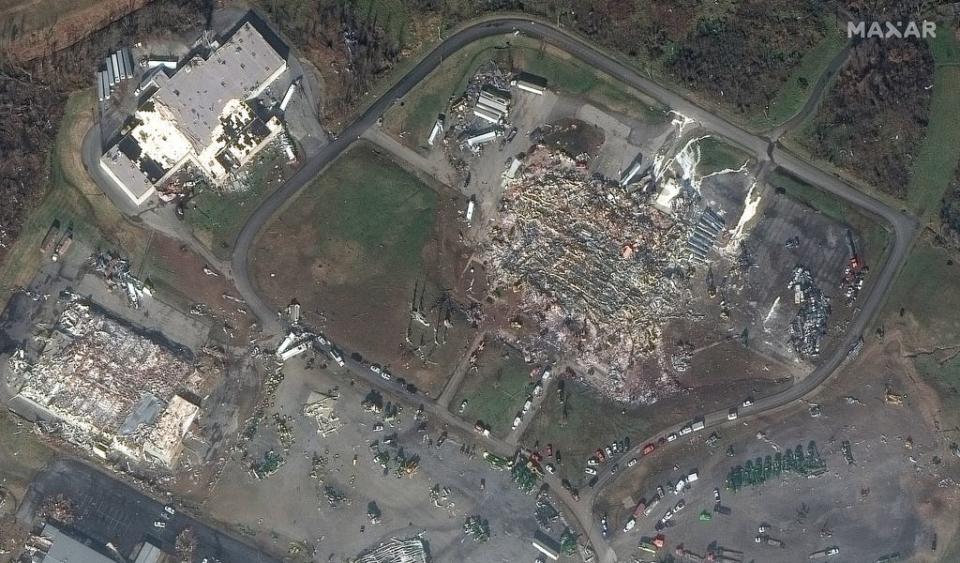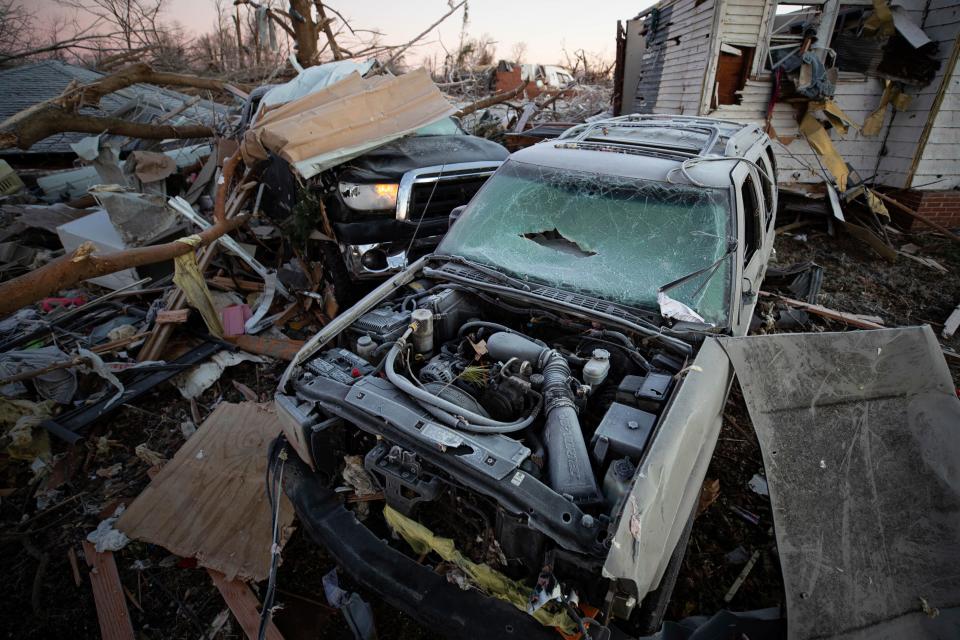Kentucky tornado latest in growing trend of Southern twisters that risk ecological disaster
When a devastating tornado cut through Western Kentucky this month – the most destructive funnel in a series that struck the country’s heartland – it took the lives of at least 76 Kentuckians.
Amidst the astonishing loss of life, a quieter accounting must also take place: the number of places where the tornado damaged sensitive facilities that store hazardous materials and wastes, threatening the environment and even survivors left to pick up the pieces.
Experts cautioned it will take time for a full tally of the tornadoes’ ecological effects in Kentucky and surrounding states.
The number of tornadoes in the South is increasing, as the traditional “tornado alley” across the Great Plains drifts east into a region with greater density of industry, people – and potential environmental hazards.
Researchers aren’t sure why. Some suspect climate change, but that has yet to be proved. Regardless, the tornado Dec. 10 highlighted the kind of risks that are increasing along with the number of twisters, particularly if the next one strikes an even more sensitive area.
At a candle factory in the hardest hit town of Mayfield, various reports indicated that chemical vats and drums overturned, leaking their contents and burning some employees. At a Pilgrim’s chicken plant nearby, eight tractor-trailers overturned, leaking diesel fuel from their saddle tanks. Seventy miles away in Earlington, the twister derailed freight cars, and to the south, extreme winds spilled fuel and paint from a Home Depot in Bowling Green.
There are more than 1,400 sites of potential pollution within a half-mile of the 160-mile path the main tornado cut through Kentucky, according to an analysis by property intelligence and technology firm LightBox, exclusively shared with USA TODAY.
Early indications are that Kentucky dodged worst-case scenarios. U.S. Environmental Protection Agency spokesperson Allison Wise said no issues had been reported from facilities that use extremely hazardous substances, and the agency had not received any requests for cleanup assistance from facilities that “store large quantities of oil.”
The Kentucky Energy and Environment Cabinet leads environmental cleanup efforts in the state. Cabinet spokesperson John Mura told USA TODAY that emergency response teams were dispatched to Mayfield and elsewhere to perform assessments and initiate cleanup. At the candle factory, a team constructed containment measures. Elsewhere in the state, teams worked to capture a pair of polymer and oil spills.

"Fortunately, there have been only a few and minor hazmat situations created by the storms," Mura said.
It might have been a different story if the tornado hadn’t stopped about an hour southwest of Louisville, the state’s largest city, said Christopher States, a toxicologist and director of the University of Louisville’s Center for Integrative Environmental Health Sciences.
“Western Louisville includes an area known as Rubbertown with chemical and other industries, not to downplay the much higher population. There also is a large military base south of Louisville,” States said. “If it reached Louisville, it would have been far worse.”
Is there a climate connection to the heartland tornadoes?
Researchers know more moisture streaming over the central USA from the warming Gulf of Mexico increases thunderstorms and intense rainfall events. They don't know what effect, if any, climate change may have on tornadoes, their increasing numbers in many Southern states or the rising number of times multiple tornadoes strike on the same day.
"The signals point to climate change, though there is still a lot of work to be done,” Victor Gensini, an associate professor in the department of geographic and atmospheric science at Northern Illinois University, told USA TODAY this year.
“What is changing is where tornadoes are occurring – up in the mid-South and down in the Plains,” he said. “And some of the climate models suggest that’s exactly what will happen in the future.”
In Alabama and Kentucky from 2000 to 2020, the annual average of reported tornadoes more than doubled from the prior 20 years, according to a USA TODAY analysis of Storm Prediction Center data. The annual average rose by more than 50% in Arkansas, Mississippi, Missouri, Tennessee and Virginia.
Kentucky’s trail of destruction
Analysis by LightBox of the tornado’s path through Kentucky and a search of 2,000 databases demonstrate the environmental risks such a force of nature presents.
Entering the state from the Tennessee border in the southwest, the tornado cut a diagonal line nearly halfway across Kentucky. Among the 1,400 potential pollution sites along the tornado’s path, LightBox found 345 properties where higher-risk chemicals such as petroleum products and industrial solvents could be stored. Of the threatened high-risk facilities statewide, nearly half were in Mayfield.
Among those were 18 facilities with above-ground storage tanks; at least 30 commercial or public buildings that contained asbestos; a landfill; and a former maintenance garage on the state Superfund list.

Tornadoes are particularly problematic disasters for cleanup efforts, said Michele Twilley, an industrial hygienist with the American Industrial Hygiene Association. Under normal circumstances, if a chemical drum spilled at a factory, measures would be in place to contain it and record whether or not it reached a waterway or natural area.
“However, with a tornado, you have such terrible forces,” Twilley said. “You have wind, you have rain, you have all of these things that could inundate whatever engineering controls you have. So then you have to start looking at, where can these chemicals move to?”
Resources are stretched tight in the aftermath of a widespread natural disaster, making cleanup and accounting more challenging, Twilley said. Private contractors normally relied upon may be on another job, or even tending to their own properties and families.
LightBox’s analysis also pointed out the risks to residential properties. As of Tuesday afternoon, official tallies of the properties affected by this month’s storm across Kentucky reached 10,000 based on insurance claims, and 1,000 or 2,000 were uninsured.
Those numbers continue to rise, and LightBox’s mapping shows at least 3,800 residential properties were in the destructive path of the tornado that swept through Mayfield and Dawson Springs.
Of those, more than 70% were constructed before 1980, a date associated with the phaseout of asbestos in building materials such as tile, flooring and insulation. The use of lead-based paint ceased a few years earlier.
Those materials can present a risk to residents returning to or cleaning up their property, along with hazards such as mold, mercury and even low-level radiation from older smoke detectors, Twilley said.
A lack of familiarity with the dangers and distress about the destruction can cloud judgment, she said. Whenever possible, tasks should be left to professionals, who are often provided by insurance companies.
“That surge of emotion can take away your ability to think rationally about your safety,” Twilley said.
This article originally appeared on USA TODAY: Kentucky tornado reveals growing risk of storms' environmental hazards

